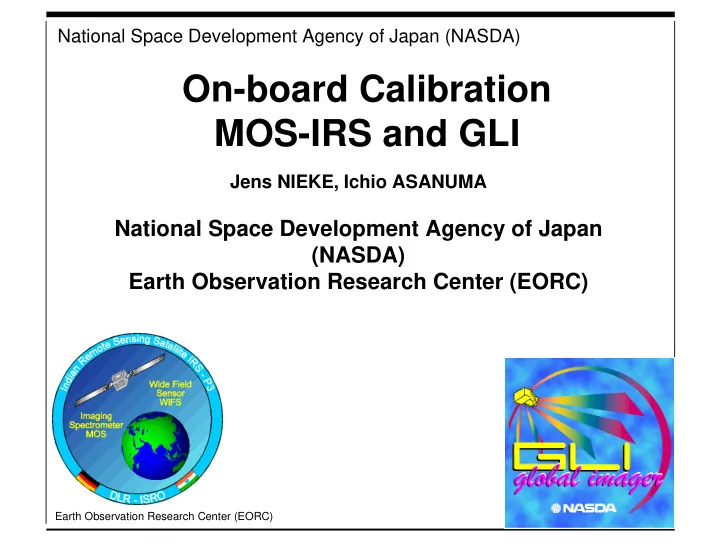

National Space Development Agency of Japan (NASDA) On-board Calibration MOS-IRS and GLI Jens NIEKE, Ichio ASANUMA National Space Development Agency of Japan (NASDA) Earth Observation Research Center (EORC) Earth Observation Research Center (EORC)
National Space Development Agency of Japan (NASDA) On-board calibration comparison 1. MOS-IRS, an experimental coastal zone imaging spectrometer 2. MOS-IRS after 4.5 years of on-board calibration 3. GLI, a full operative global orientated whiskbroom scanner 4. GLI on-board calibration 5. Comparison GLI — MOS-IRS calibration 6. Conclusion Earth Observation Research Center (EORC)
National Space Development Agency of Japan (NASDA) Earth Observation Research Center (EORC)
National Space Development Agency of Japan (NASDA) Earth Observation Research Center (EORC)
National Space Development Agency of Japan (NASDA) Earth Observation Research Center (EORC)
National Space Development Agency of Japan (NASDA) Results of MOS-IRS on-board calibration Lamps: total error: 1.1%; frequency: before each orbit – relative radiometric, linearity, spectral checks – show that sensor sensitivity is stable or increases slowly (MOS-B up to +7%) – no changes of linearity and spectral checks Sun: total error: 2.0 %; frequency: ca. 15 times a year – absolute radiometric calibration – error due to stray light effects in the SunCal Unit (straylight has a strong correlation with seasonal variations of Sun incidence angle) – no degradation of the diffuser plate (state: April 1996 — October 2000) Earth Observation Research Center (EORC)
National Space Development Agency of Japan (NASDA) After 4.5 years of MOS-IRS on-board calibration • Sun calibration is a reliable source for absolute calibration • Spectralon is a very suitable and stable material for in-orbit Sun calibration • lamp calibration is a reliable source for relative calibration Lessons learnt: Lessons learnt: • accurate knowledge of the orbit and illumination geometry is very important for accuracy of the Sun calibration • more attention to stray light : reduction by a more symmetrical baffle system with respect to the incoming Sun radiation • different signal levels of Sun calibration ( grey diffuser ) Sources: Sümnich & Schwarzer private communication Sümnich & Schwarzer; In-flight calibration of the MOS; Int.J.Remote Sensing (1998) Earth Observation Research Center (EORC)
National Space Development Agency of Japan (NASDA) GLI on-board calibration Diffuser Lamps Blackbody Sun cal window Earth Observation Research Center (EORC)
National Space Development Agency of Japan (NASDA) GLI on-board calibration (1) sun and lamp blackbody calibration cold space background scanning mirror telescope (primary optics) FOV= +/- ~40° Earth surface scan Earth Observation Research Center (EORC)
National Space Development Agency of Japan (NASDA) GLI on-board calibration (2) monitor- lamps Sun diodes (underneath) diffuser tranmitting screen Earth Observation Research Center (EORC)
National Space Development Agency of Japan (NASDA) Comparison GLI — MOS-IRS GLI MOS-IRS Sun: • Reduction of solar • Direct Sun illumination illumination intensity by a • Shutter protects diffuser transmitting screen (plate when SunCal is not required with many holes) • Monitor diodes • SunCal every orbit • LampCal every orbit Lamps: • LampCal frequently • 2 lamps with different signal • One signal level for each levels ensure relative lamp => no linearity spectral/ radiometric cal. measurements and linearity measurements • Monitor diodes • No thermal channels Thermal: • Blackbody and cold space • Excellent results Results: • Difficult to forecast Earth Observation Research Center (EORC)
National Space Development Agency of Japan (NASDA) Conclusion The high potential of on-board calibration has been shown • a very high calibration accuracy can be achieved • in contrast to vicarious calibration, on-board calibration is only technology related Possible problems for GLI on-board calibration • possible straylight during Sun calibration • degradation and/or contamination of the lamps, diffuser and/or transmitting screen More effort on on-board calibration such as • straylight measurements / simulation (SunCal system) • degradation measurements / simulation (diffuser, lamps) Earth Observation Research Center (EORC)
National Space Development Agency of Japan (NASDA) After launch calibration of EO Sensors Why? possible sensitivity change of channels during the mission • 5 - 7 years mission duration • space environment factors CZCS channels long-term degradation (1979-86) How accurate? (Evans & Gordon 1994) by vicarious calibration: by in-flight calibration: ε ~ 1% ε ε ε ε ε > 3% ε ε mainly driven by mainly driven by • design parameters • dependency on other radiometers • technology related • TOA modelling accuracy Earth Observation Research Center (EORC)
National Space Development Agency of Japan (NASDA) GLI transmitting screen Seasonal variations of Sun incidence angle in the SunCal Unit Earth Observation Research Center (EORC)
National Space Development Agency of Japan (NASDA) Earth Observation Research Center (EORC)
Recommend
More recommend